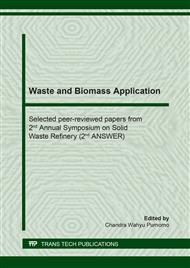p.84
p.90
p.96
p.102
p.108
p.113
p.119
p.125
p.130
Zinc Oxide Recovery from Solid Waste of Electric Arc Furnace Dust (EAFD) Using Hydrometallurgical Method
Abstract:
Indonesia coal ash is predicted to reach 10.8 million tons in the year 2020 but its utilization is still limited. In the last decade, coal ash has become a promising REY source candidate. To determine the potency of REY in Indonesia coal ash, information about element concentration and mineralogy of the ash is essential. In this study, coal ash samples were taken from Paiton-2, Pacitan, Rembang, and Tanjung Jati coal-fired power plants. Element content and mineralogy were analyzed using Inductive Couple Plasma Mass Spectroscopy/Atomic Emission Spectroscopy (ICP-MS/AES), X-Ray Diffractometer (XRD) and petrographic. The results showed that coal fly ash and bottom ash contains critical REY in the range of 38% to 41% with Coutlook larger than one. XRD analysis showed that both fly ash and bottom ash have similar mineral phases with slightly different concentrations. The mineral phase is dominated by amorphous glass, quartz, Fe-bearing minerals, and unburned carbon. The amorphous glass phase in fly ash is in the range of 23 to 34% while in bottom ash between 14 and 34%. Unburned carbon content in fly ash and bottom ashes are 7-13% and 7-19%, respectively. Fe-bearing mineral content in fly ash is 15-20% and bottom ash is 13-20%. In addition, Indonesia coal ash has a higher Heavy-REY enrichment factor than Light-REY. The Enrichment Factor of HREY in fly ash is as much as 1.3 times (in average) of the bottom ash.
Info:
Periodical:
Pages:
108-112
Citation:
Online since:
June 2020
Price:
Сopyright:
© 2020 Trans Tech Publications Ltd. All Rights Reserved
Share:
Citation:


